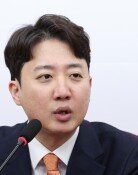Yoon, Biden declare Washington Declaration
Yoon, Biden declare Washington Declaration
Posted April. 28, 2023 08:12,
Updated April. 28, 2023 08:12
South Korean President Yoon Suk Yeol and U.S. President Joe Biden on Wednesday (local time) made a joint announcement of the Washington Declaration to put an enhanced level of extended deterrence into action in the face of North Korean nuclear and missile threats. The establishment of a new Nuclear Consultative Group (NCG) was announced in line with the two leaders’ common view that any nuclear attack by the regime will only face all kinds of swift, overwhelming, and decisive responses, including U.S. nuclear weapons. President Biden particularly stated during a joint press conference that Pyongyang’s nuclear attack would lead to the regime's demise.
The Washington Declaration, which is assessed as the first separate document on the two allies’ strong determination to respond to North Korean nuclear issues, is a result of the South Korean government’s dedicated efforts. After all, the two allies alike consider the ever-advancing nuclear threats a more urgent issue than any topic that could have been discussed on the occasion of the 70th anniversary of their alliance. Many parts of the special document clearly reflect how dedicated the two heads of state are to addressing the topical issue. Washington even made it clear during the meeting that if Pyongyang uses nuclear weapons or even makes such attempts, Washington will get the origin of the attack completely removed, according to the South Korean presidential office.
Having said that, a closer look at the details tells us that the document is half successful. The foundation of a new vice-ministerial consultative body that opens four times a year was agreed upon jointly as part of the declaration. However, Seoul only demonstrated its complete trust in Washington’s extended deterrence commitments and reaffirmed the observance of its obligations as per the Nonproliferation Treaty (NPT). Presumably, it took back the argument for a possible independent nuclear armament that President Yoon had previously envisioned. Additionally, as the declaration clarifies South Korean conventional support to U.S. nuclear operations in case of emergency, it is only a reaffirmation of the asymmetry of their alliance.
The NCG was inspired by the Nuclear Planning Group as part of the NATO nuclear sharing program. In this sense, an insider from the South Korean presidential office said that the system could be, in effect, associated with nuclear sharing. Nevertheless, not any tactical nuclear weapons are not deployed on the Korean peninsula, and Washington does not seem to consider it at all, unlike the European nuclear sharing program where Washington and its European allies jointly plan and operate U.S. nuclear weapon systems installed in Europe. Under these circumstances, plausible, unrealistic explanations never sound compelling but only offer false hope.
Despite such limitations, Seoul should ensure that the NCG serves as a practical system going beyond a mere channel of dialogue or discussion as the two allies jointly built a mechanism for information sharing and joint planning about the operation of nuclear weapons. The NATO NPG makes operational plans on nuclear systems in the three-phased structure of ministerial, standing representative and working-level communication. Likewise, the Seoul-Washington NCG should start from a framework where the two countries’ working-level crews constantly communicate in the same venue. Only this high level of coordination and seamless execution planning can make the alliance strong enough to deter North Korean nuclear provocations.




![“한동훈, 정치생명 걸고 무소속 출마해 평가받는 것 고려할만”[정치를 부탁해]](https://dimg.donga.com/c/138/175/90/1/wps/NEWS/IMAGE/2026/01/19/133186982.1.jpg)


